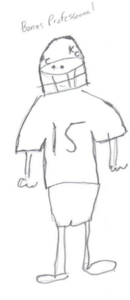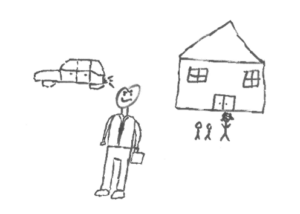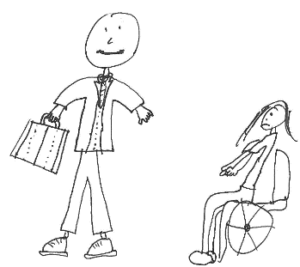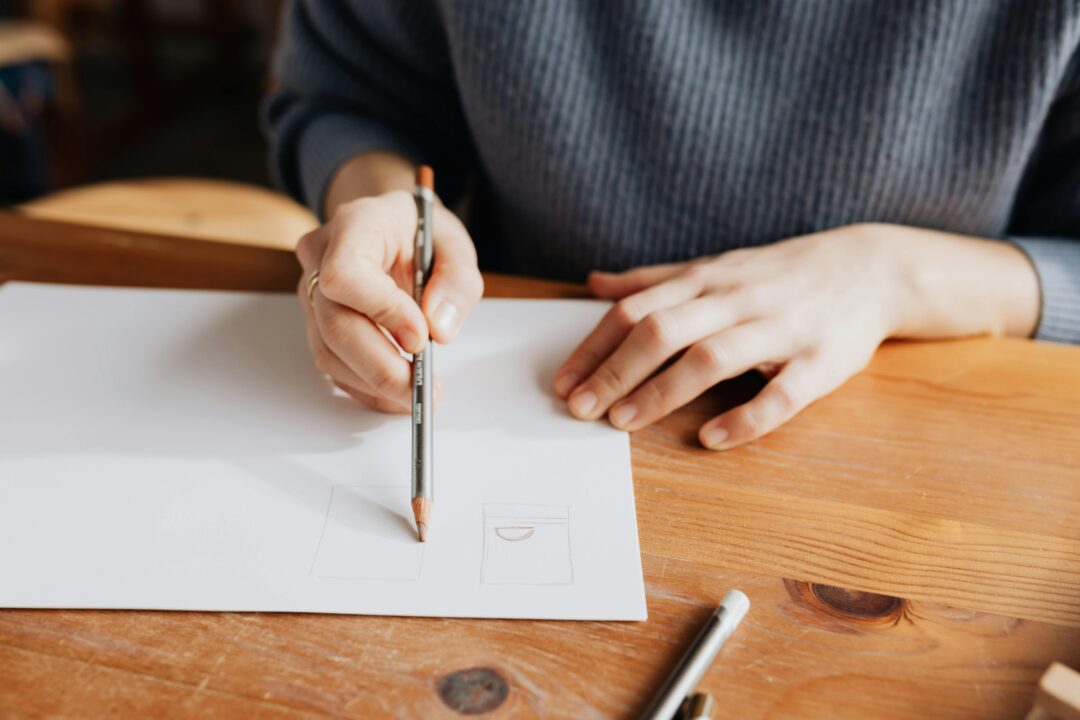By: Barb Glesner Fines, Dean Emerita and Rubey M. Hulen Professor of Law,
UMKC School of Law
As a new academic year begins, it’s that “fresh box of crayons” time of year. And so time for artwork to  help us in understanding what it means to be a professional.
help us in understanding what it means to be a professional.
For over two decades, I have begun my Professional Responsibility (PR) class with a drawing exercise in which I ask students to “draw a picture of a professional.”[1] You could use this exercise in any course as we want our students to think about their professional identity formation throughout law school. Over the years, some things have remained constant with the pictures produced from this exercise – for example, briefcases still appear as the most frequent symbol of professionals.

Some things have changed. Women began appearing in about 2002 even though I had plenty of female students in my PR classes prior to 2002. Images of wealth and status waxed and waned. This year, after a six-year hiatus from teaching the PR course, I again repeated the experiment to see if new trends and assumptions were emerging. Here is my brief analysis of the new picture of professionals my students are bringing into the PR course.
- It’s still hard work. Those briefcases are still there, this year with a litigation cart full of exhibits and a file cabinet stuffed full.
- Technology is ubiquitous. Laptops, cell phones, smart watches… they haven’t quite replaced the
 briefcase, but they appear nonetheless.
briefcase, but they appear nonetheless. - Women are professionals. It’s hard to discern demographic data with stick figures (the artistic abilities of our students vary widely), but about 50% of the professionals appear to be women.
- Not all professionals are attorneys. Professional athletes once again appeared as “bonus professionals”

- Clients are in the picture! For nearly every year in which I conducted this exercise, the professionals in the picture were there alone. Occasionally a judge would appear. One-third of this semester’s students had a client in the picture (which is the punchline of the exercise – “a professional keeps the client in the picture”). The increased experiential opportunities (and requirements) of today’s students may explain why their picture of a professional reflects this vision of a service professional.
If you would like to see your students’ images of professionals, here are some suggestions.
- Think about timing. I like to use this as an assignment on the first or second day. It’s a good ice-breaker, the students don’t have any preset notions of what they are “supposed” to draw, and you can use the pictures to develop themes you will emphasize during the course. For example, I always end the exercise by emphasizing to students that, as service professionals, we need to keep the client “in the picture” and remember that there are others in the picture as well for whom we have responsibilities.
- Think about the image you are looking for. I start with “professional” because I use the exercise in professional responsibility, but you could ask for images of clients, lawyers, judges, or advocates… or
 even abstract concepts like justice or fairness.
even abstract concepts like justice or fairness. - Emphasize to the students that artistic talent doesn’t matter and that symbols are welcome. Discourage the use of words. Let students know that you will be showing some or all of the pictures to the class. Emphasize that the assignment is anonymous and they need not claim their artwork.
- Collect the pictures and quickly sort through them for thematic elements. Use the document camera and just show one picture after another, noting the themes that jump out at you. Students will laugh and relax, which enhances learning. Difficult subjects can be raised without a lot of elaboration. I’ve had pictures raisestudent concerns about inclusion, wellness, workload, debt, and other deeply personal and difficult subjects. When students see they are not alone in these concerns, it opens doors for conversations.
- I have never followed up the exercise with a written reflection, but one certainly could do so effectively.
- Needless to say, while this exercise gives me a great deal of formative assessment of student attitudes and assumptions, it is not for a grade.


For ourselves, too, drawing exercises can be an excellent tool for capturing snapshots of perspectives and as a catalyst for reflection and conversation about professional identity. Recently, I had the opportunity to ask a group of legal educators to complete this same exercise but with the prompt to “draw a picture of a law professor.” [2]
How do you picture your professional identity?
[1] To read more about this exercise and see pictures from students from 2007-2017, see Barbara Glesner Fines, Picturing Professionals: The Emergence of a Lawyer’s Identity, 14 U. St. Thomas L.J. 437 (2018) available at: https://irlaw.umkc.edu/faculty_works/94.
[2] My article exploring the identity of law professors based on this exercise is forthcoming in Volume 2 of the Journal of Law Teaching and Learning (forthcoming 2024) at https://lawrepository.ualr.edu/lawteachingjournal/.

Barbara Glesner Fines is the Dean Emerita and Rubey M. Hulen Professor of Law at the University of Missouri-Kansas City School of Law.



